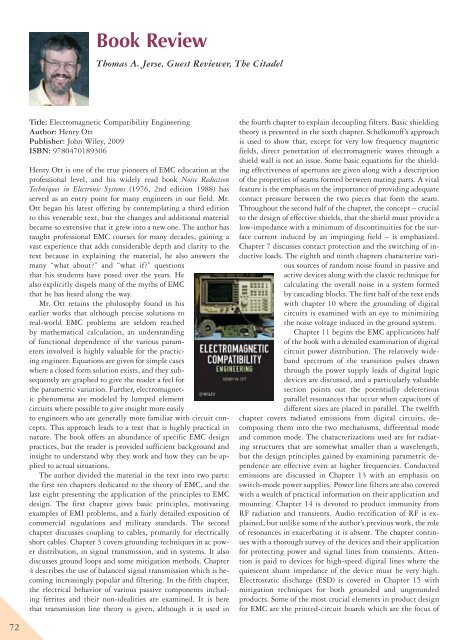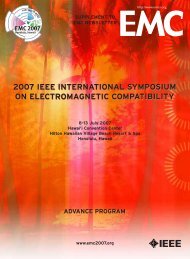Tutorial: EMC & Signal Integrity using SPICE, page 44 - IEEE EMC ...
Tutorial: EMC & Signal Integrity using SPICE, page 44 - IEEE EMC ...
Tutorial: EMC & Signal Integrity using SPICE, page 44 - IEEE EMC ...
Create successful ePaper yourself
Turn your PDF publications into a flip-book with our unique Google optimized e-Paper software.
72<br />
Book Review<br />
Thomas A. Jerse, Guest Reviewer, The Citadel<br />
Title: Electromagnetic Compatibility Engineering<br />
Author: Henry Ott<br />
Publisher: John Wiley, 2009<br />
ISBN: 9780470189306<br />
Henry Ott is one of the true pioneers of <strong>EMC</strong> education at the<br />
professional level, and his widely read book Noise Reduction<br />
Techniques in Electronic Systems (1976, 2nd edition 1988) has<br />
served as an entry point for many engineers in our field. Mr.<br />
Ott began his latest offering by contemplating a third edition<br />
to this venerable text, but the changes and additional material<br />
became so extensive that it grew into a new one. The author has<br />
taught professional <strong>EMC</strong> courses for many decades, gaining a<br />
vast experience that adds considerable depth and clarity to the<br />
text because in explaining the material, he also answers the<br />
many “what about?” and “what if?” questions<br />
that his students have posed over the years. He<br />
also explicitly dispels many of the myths of <strong>EMC</strong><br />
that he has heard along the way.<br />
Mr. Ott retains the philosophy found in his<br />
earlier works that although precise solutions to<br />
real-world <strong>EMC</strong> problems are seldom reached<br />
by mathematical calculation, an understanding<br />
of functional dependence of the various parameters<br />
involved is highly valuable for the practicing<br />
engineer. Equations are given for simple cases<br />
where a closed form solution exists, and they subsequently<br />
are graphed to give the reader a feel for<br />
the parametric variation. Further, electromagnetic<br />
phenomena are modeled by lumped element<br />
circuits where possible to give insight more easily<br />
to engineers who are generally more familiar with circuit concepts.<br />
This approach leads to a text that is highly practical in<br />
nature. The book offers an abundance of specific <strong>EMC</strong> design<br />
practices, but the reader is provided sufficient background and<br />
insight to understand why they work and how they can be applied<br />
to actual situations.<br />
The author divided the material in the text into two parts:<br />
the first ten chapters dedicated to the theory of <strong>EMC</strong>, and the<br />
last eight presenting the application of the principles to <strong>EMC</strong><br />
design. The first chapter gives basic principles, motivating<br />
examples of EMI problems, and a fairly detailed exposition of<br />
commercial regulations and military standards. The second<br />
chapter discusses coupling to cables, primarily for electrically<br />
short cables. Chapter 3 covers grounding techniques in ac power<br />
distribution, in signal transmission, and in systems. It also<br />
discusses ground loops and some mitigation methods. Chapter<br />
4 describes the use of balanced signal transmission which is becoming<br />
increasingly popular and filtering. In the fifth chapter,<br />
the electrical behavior of various passive components including<br />
ferrites and their non-idealities are examined. It is here<br />
that transmission line theory is given, although it is used in<br />
the fourth chapter to explain decoupling filters. Basic shielding<br />
theory is presented in the sixth chapter. Schelkunoff’s approach<br />
is used to show that, except for very low frequency magnetic<br />
fields, direct penetration of electromagnetic waves through a<br />
shield wall is not an issue. Some basic equations for the shielding<br />
effectiveness of apertures are given along with a description<br />
of the properties of seams formed between mating parts. A vital<br />
feature is the emphasis on the importance of providing adequate<br />
contact pressure between the two pieces that form the seam.<br />
Throughout the second half of the chapter, the concept – crucial<br />
to the design of effective shields, that the shield must provide a<br />
low-impedance with a minimum of discontinuities for the surface<br />
current induced by an impinging field – is emphasized.<br />
Chapter 7 discusses contact protection and the switching of inductive<br />
loads. The eighth and ninth chapters characterize various<br />
sources of random noise found in passive and<br />
active devices along with the classic technique for<br />
calculating the overall noise in a system formed<br />
by cascading blocks. The first half of the text ends<br />
with chapter 10 where the grounding of digital<br />
circuits is examined with an eye to minimizing<br />
the noise voltage induced in the ground system.<br />
Chapter 11 begins the <strong>EMC</strong> applications half<br />
of the book with a detailed examination of digital<br />
circuit power distribution. The relatively wideband<br />
spectrum of the transition pulses drawn<br />
through the power supply leads of digital logic<br />
devices are discussed, and a particularly valuable<br />
section points out the potentially deleterious<br />
parallel resonances that occur when capacitors of<br />
different sizes are placed in parallel. The twelfth<br />
chapter covers radiated emissions from digital circuits, decomposing<br />
them into the two mechanisms, differential mode<br />
and common mode. The characterizations used are for radiating<br />
structures that are somewhat smaller than a wavelength,<br />
but the design principles gained by examining parametric dependence<br />
are effective even at higher frequencies. Conducted<br />
emissions are discussed in Chapter 13 with an emphasis on<br />
switch-mode power supplies. Power line filters are also covered<br />
with a wealth of practical information on their application and<br />
mounting. Chapter 14 is devoted to product immunity from<br />
RF radiation and transients. Audio rectification of RF is explained,<br />
but unlike some of the author’s previous work, the role<br />
of resonances in exacerbating it is absent. The chapter continues<br />
with a thorough survey of the devices and their application<br />
for protecting power and signal lines from transients. Attention<br />
is paid to devices for high-speed digital lines where the<br />
quiescent shunt impedance of the device must be very high.<br />
Electrostatic discharge (ESD) is covered in Chapter 15 with<br />
mitigation techniques for both grounded and ungrounded<br />
products. Some of the most crucial elements in product design<br />
for <strong>EMC</strong> are the printed-circuit boards which are the focus of

















